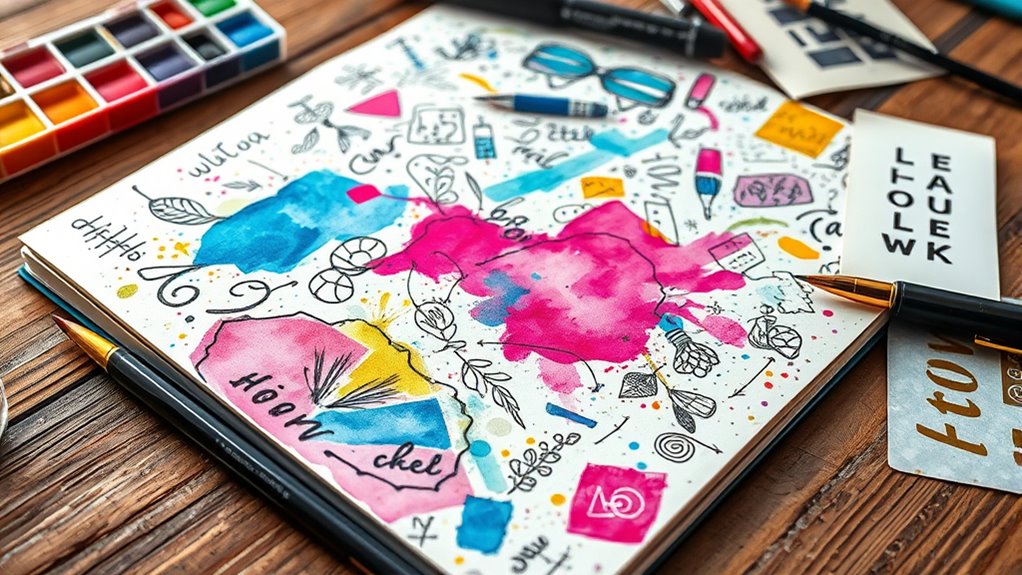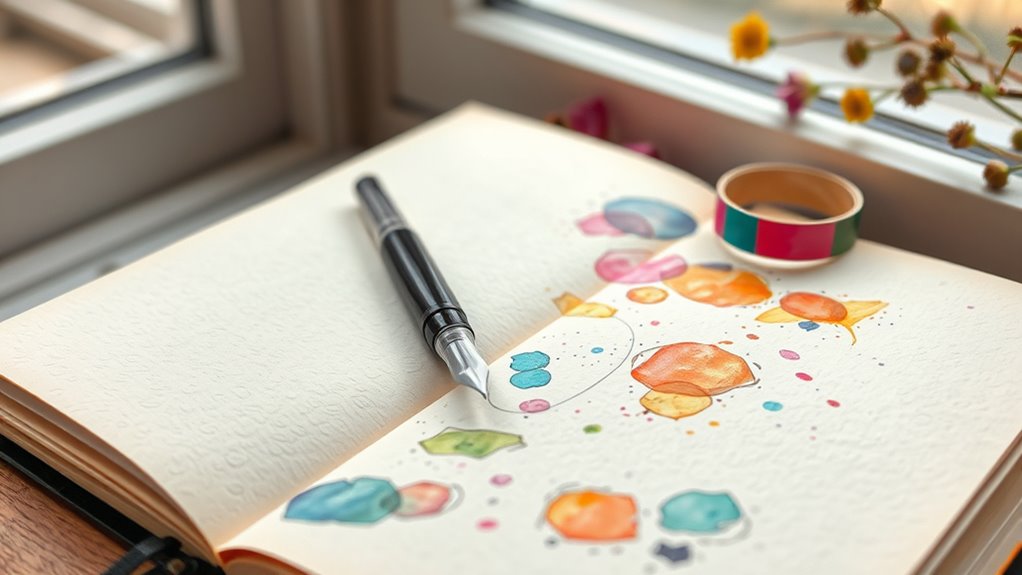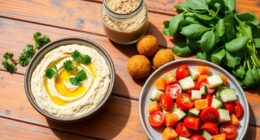Creative journaling techniques combine visual storytelling, prompts, and expressive exercises to help you explore emotions and uncover insights. Use simple sketches, collages, symbols, or timelines to express feelings beyond words and gain new perspectives. Focus on freeing your creativity rather than artistic skill, and watch as patterns and themes emerge over time. Keep experimenting with these methods, and you’ll discover even more ways to connect with your inner self along the way.
Key Takeaways
- Incorporate visual storytelling with sketches, symbols, and collages to express complex emotions beyond words.
- Use prompts like drawing moments of joy or creating visual timelines to inspire creative entries.
- Focus on expressive, simple visuals rather than artistic perfection to enhance self-awareness.
- Experiment with combining images and written reflections to deepen understanding and uncover patterns.
- Practice regularly to strengthen visual storytelling skills and foster ongoing self-discovery through imagery.

Creative journaling is a powerful way to open your imagination and deepen self-awareness. One of its most engaging techniques is visual storytelling, where you combine images, sketches, and symbols to convey your thoughts and feelings. Instead of relying solely on words, you use visuals to express complex emotions or ideas that might be difficult to articulate. This approach encourages you to see your experiences from new angles and access hidden insights. To get started, you can use prompts and exercises designed specifically for visual storytelling. For example, pick a prompt like “Describe a recent moment of joy” and then illustrate that scene with sketches or collages. These prompts act as catalysts, sparking your creativity and helping you dive deeper into your subconscious. Exercises such as creating a visual timeline of your week or drawing symbols that represent your current emotions can make your journaling sessions more dynamic and meaningful.
Using prompts and exercises in this way provides a structured yet flexible framework for your creativity to flow. You don’t need to be an artist; simple stick figures or abstract shapes work just as well. The goal is to express, not to perfect. With each prompt, you challenge yourself to think visually and interpret your experiences in new ways. For instance, you might be asked to draw a map of your emotional landscape or create a visual diary of your goals. These exercises help you tap into your intuitive side, making your journaling more engaging and revealing. Over time, you’ll notice patterns and themes emerging from your visual stories, giving you clearer insight into your inner world.
Incorporating visual storytelling through prompts and exercises also adds variety to your journaling practice, keeping it fresh and inspiring. It pushes you beyond traditional writing and encourages experimentation. Whether you’re doodling in the margins or creating detailed collages, each image becomes a bridge to your subconscious mind. This technique enhances your ability to communicate complex feelings and thoughts that words alone might not capture. Plus, it boosts your confidence in using different forms of expression. As you regularly practice with these prompts, you’ll find your visual storytelling skills strengthening, enriching your overall journaling experience and helping you connect more deeply with yourself.
Frequently Asked Questions
Can Creative Journaling Boost Mental Health Effectively?
Yes, creative journaling can boost your mental health effectively. By engaging in emotional expression through writing or art, you may find it easier to process feelings and reduce stress. This active process helps you gain clarity, release pent-up emotions, and improve overall well-being. Regular journaling creates a safe space for self-reflection, making it a powerful tool for stress relief and mental health support.
What Materials Are Best for Beginners?
If you think you need a fancy set of supplies to start journaling, think again. For beginner supplies, just grab a simple notebook, some pens or pencils, and maybe colored markers for flair. A materials overview shows you don’t need anything extravagant—just the basics to get your creative juices flowing. Start small, keep it simple, and let your imagination do the rest. Who knew journaling could be so low-cost?
How Often Should I Journal Creatively?
You should journal creatively at least a few times a week to build consistency, but don’t feel pressured to do it daily. Find a frequency that fits your schedule and feels enjoyable. To help maintain your journaling frequency, set small, achievable goals and create a dedicated space. Consistency tips include keeping your journal accessible and making it a relaxing, rewarding part of your routine, so it becomes a habit you look forward to.
Can I Combine Digital and Physical Journaling?
Absolutely, you can combine digital and physical journaling with hybrid methods and digital integration. This approach lets you enjoy the tactile experience of writing while benefiting from digital tools like apps, images, and hyperlinks. You might write by hand for reflection and use digital platforms for editing or adding multimedia. Blending both methods keeps your journaling fresh, flexible, and personalized, enhancing your creative process and making journaling more engaging.
Are There Specific Themes to Explore in Creative Journaling?
Yes, you can explore themes like visual storytelling and abstract expression in your creative journaling. Think of your journal as a canvas where your thoughts and emotions dance freely, capturing vivid scenes or swirling ideas. Immerse yourself in themes like journeys, dreams, or personal growth, letting your sketches, words, and colors weave a tapestry that reflects your inner world. These themes turn your journal into a vibrant mirror of your soul’s stories.
Conclusion
Think of your journal as a garden, where your thoughts are seeds waiting to bloom. By trying these creative techniques, you nurture your ideas, allowing them to grow into vibrant expressions of yourself. Remember, each page is a fertile ground for your imagination to flourish. So, pick up your pen with confidence and watch your inner landscape blossom into a colorful, inspiring masterpiece—your personal sanctuary of creativity.










